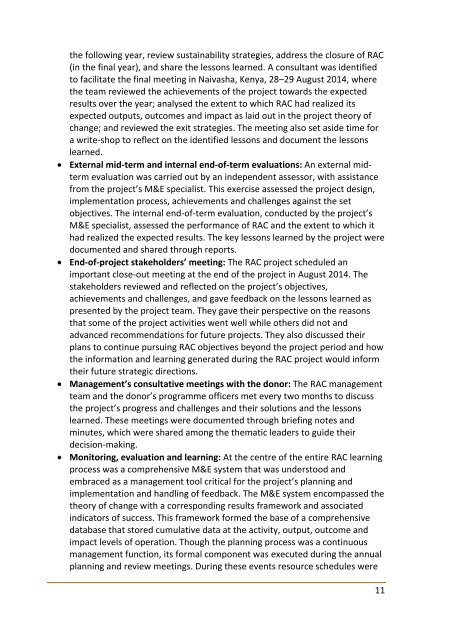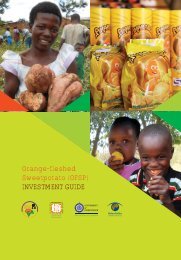Recommendation
Up89Y
Up89Y
Create successful ePaper yourself
Turn your PDF publications into a flip-book with our unique Google optimized e-Paper software.
the following year, review sustainability strategies, address the closure of RAC<br />
(in the final year), and share the lessons learned. A consultant was identified<br />
to facilitate the final meeting in Naivasha, Kenya, 28–29 August 2014, where<br />
the team reviewed the achievements of the project towards the expected<br />
results over the year; analysed the extent to which RAC had realized its<br />
expected outputs, outcomes and impact as laid out in the project theory of<br />
change; and reviewed the exit strategies. The meeting also set aside time for<br />
a write‐shop to reflect on the identified lessons and document the lessons<br />
learned.<br />
External mid‐term and internal end‐of‐term evaluations: An external midterm<br />
evaluation was carried out by an independent assessor, with assistance<br />
from the project’s M&E specialist. This exercise assessed the project design,<br />
implementation process, achievements and challenges against the set<br />
objectives. The internal end‐of‐term evaluation, conducted by the project’s<br />
M&E specialist, assessed the performance of RAC and the extent to which it<br />
had realized the expected results. The key lessons learned by the project were<br />
documented and shared through reports.<br />
End‐of‐project stakeholders’ meeting: The RAC project scheduled an<br />
important close‐out meeting at the end of the project in August 2014. The<br />
stakeholders reviewed and reflected on the project’s objectives,<br />
achievements and challenges, and gave feedback on the lessons learned as<br />
presented by the project team. They gave their perspective on the reasons<br />
that some of the project activities went well while others did not and<br />
advanced recommendations for future projects. They also discussed their<br />
plans to continue pursuing RAC objectives beyond the project period and how<br />
the information and learning generated during the RAC project would inform<br />
their future strategic directions.<br />
Management’s consultative meetings with the donor: The RAC management<br />
team and the donor’s programme officers met every two months to discuss<br />
the project’s progress and challenges and their solutions and the lessons<br />
learned. These meetings were documented through briefing notes and<br />
minutes, which were shared among the thematic leaders to guide their<br />
decision‐making.<br />
Monitoring, evaluation and learning: At the centre of the entire RAC learning<br />
process was a comprehensive M&E system that was understood and<br />
embraced as a management tool critical for the project’s planning and<br />
implementation and handling of feedback. The M&E system encompassed the<br />
theory of change with a corresponding results framework and associated<br />
indicators of success. This framework formed the base of a comprehensive<br />
database that stored cumulative data at the activity, output, outcome and<br />
impact levels of operation. Though the planning process was a continuous<br />
management function, its formal component was executed during the annual<br />
planning and review meetings. During these events resource schedules were<br />
11



